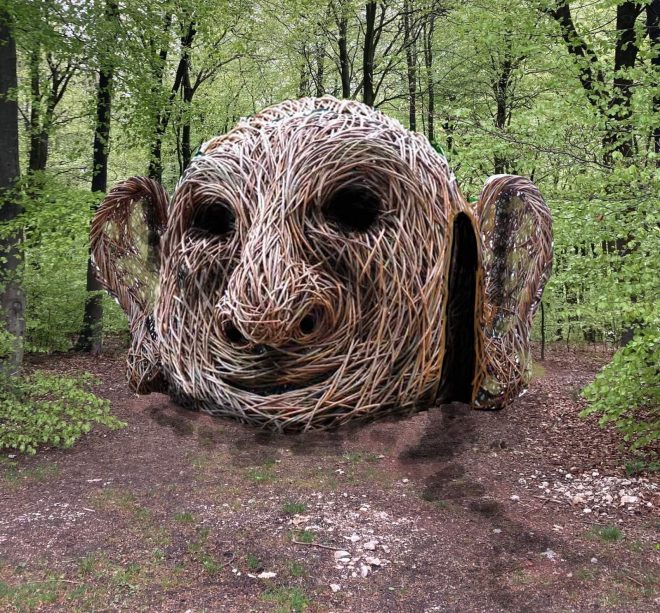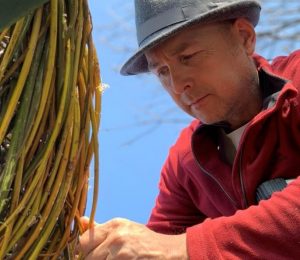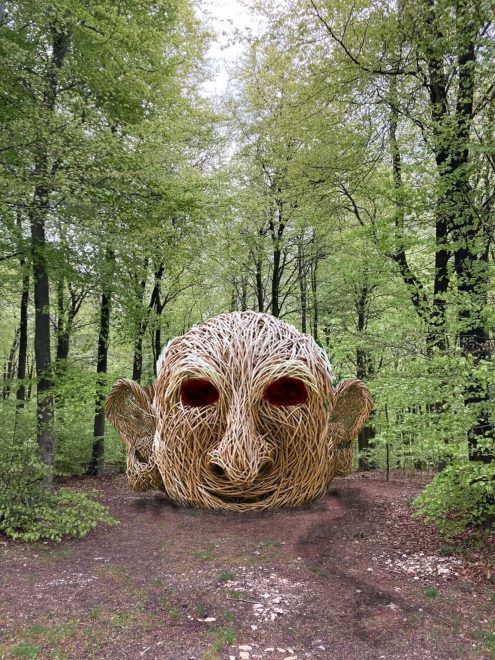Magical sculpture inspired by local legend takes shape in woodland
April 11, 2022

If you go down to the woods today, you’re sure of a big surprise…in the form of a beautifully-crafted giant’s head.
The incredible sculpture, made of woven branches, is currently in the making at Queen Elizabeth Country Park and is due to be unveiled to the public during the Easter school holidays.
Made by internationally-acclaimed environmental artist Mark Antony Haden Ford, the artwork depicts Ascapart, a legendary giant from Hampshire folklore.
Mark will spend over 80 hours painstakingly weaving locally-sourced hazel and willow to make the sculpture, which will be strong enough to last for several years (picture shows a mock-up of completed sculpture).
Storyteller Chris North will be holding storytelling sessions inside Ascapart’s head on Saturday, 23 April, and Mark is inviting the public to take part in a giant mandala-making workshop using natural materials. The event takes place from 10am to 4pm.
The arts and heritage project has been supported by the South Downs National Park Authority and has a simple call to action: “Stop A Minute”.
 Mark, based in Slindon, West Sussex, explained: “This is part of a lockdown legacy project to encourage people who might not ordinarily access the countryside to go out and enjoy it.
Mark, based in Slindon, West Sussex, explained: “This is part of a lockdown legacy project to encourage people who might not ordinarily access the countryside to go out and enjoy it.
“The idea is just to come, be and stop for a minute, taking in the surroundings and nature. The head of Ascapart is a place where you can stop for a moment, take stock and connect with the woodland landscape.
“You walk in via the sideburn of the giant’s head. The sculpture will be around 3m across and 4m high, so it will be big enough to have storytelling sessions in the head and for a family to sit inside.”
Mark, whose other recent creations include an outdoor classroom at Amberley School, is working at the country park, fresh from returning from the world rock-stacking championships in Texas.
Mark, who has been a land artist for almost 30 years, said: “I have the privilege of travelling the world making sculptures from natural materials. I create site-specific works that are connected to the location and the landscape around them.
“For this project, I’m working with coppiced materials all sourced from within the South Downs National Park. The South Downs is full of hazel because of its history as an iron-making region. Many hazel woodlands were planted in the 1500s because it was needed for charcoal, so hazel has been managed in this area for centuries.
“By the First World War unfortunately many of those people who managed the woodlands did not return from the war, so today we have these huge estates of overstood hazel woodland. I have a real connection with the materials, and I pride myself on using techniques and traditional methods that have been used for centuries.”
 Anooshka Rawden, who leads cultural heritage for the National Park Authority, said: “The South Downs has a celebrated history spanning many centuries of legends around magical giants. Mark’s skill is in his sensitivity to landscape and materials, and a playfulness in form and approach, and we hope families ‘stop a minute’ to enjoy this ‘living’ art work linked to the folklore of Hampshire.”
Anooshka Rawden, who leads cultural heritage for the National Park Authority, said: “The South Downs has a celebrated history spanning many centuries of legends around magical giants. Mark’s skill is in his sensitivity to landscape and materials, and a playfulness in form and approach, and we hope families ‘stop a minute’ to enjoy this ‘living’ art work linked to the folklore of Hampshire.”
According to the saga, Ascapart was 30ft tall but the smallest of his land and was defeated after his club – made from a whole tree – was swung at Sir Bevis of Hampton and became stuck in soft ground. Rather than slaying the giant, Sir Bevis decided to make him his Squire. Later Ascapart betrayed Bevis and took his wife Josiane, who was imprisoned, with Ascapart as her jailer. For his part, Ascapart was later killed by Bevis’ friends when they freed Josiane.
Large medieval paintings of Sir Bevis and Ascapart can be found in the Southampton Bargate Monument Gallery. Some roads in Hampshire are also believed to be named after Sir Bevis and Ascapart (sometimes spelt Ascupart).
Ascapart is part of a long mythological history of giants in this area of England. Queen Elizabeth Country Park was once the site of a “Giant’s Chair” created by artist Robert Jakes who installed it in 1991. Local artist and researcher Laura Buckle carried out extensive research into the giants chair and more information on the project is available on Hampshire County Council’s website at www.hants.gov.uk/thingstodo/countryparks/qecp

